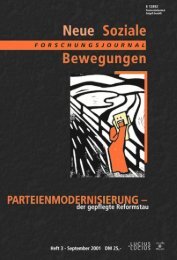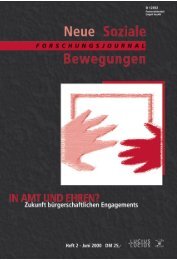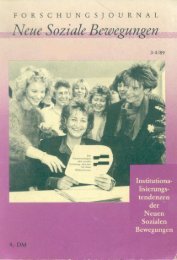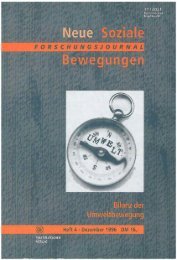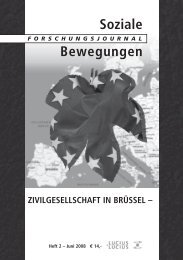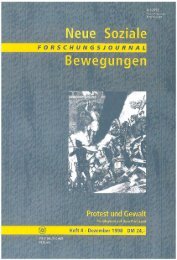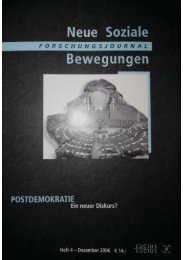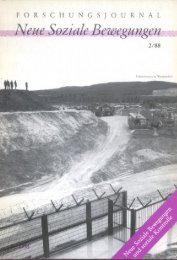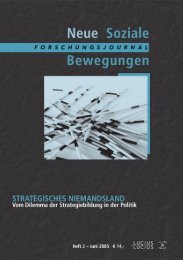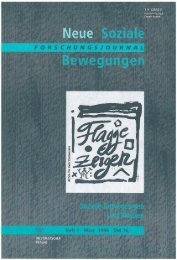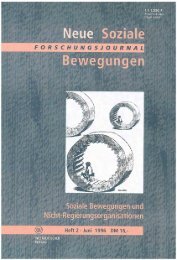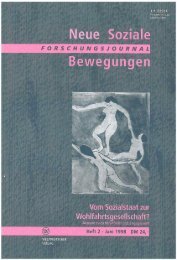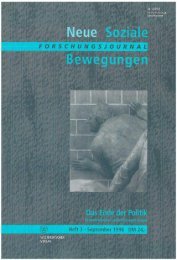Vollversion (5.75 MB) - Forschungsjournal Soziale Bewegungen
Vollversion (5.75 MB) - Forschungsjournal Soziale Bewegungen
Vollversion (5.75 MB) - Forschungsjournal Soziale Bewegungen
Sie wollen auch ein ePaper? Erhöhen Sie die Reichweite Ihrer Titel.
YUMPU macht aus Druck-PDFs automatisch weboptimierte ePaper, die Google liebt.
44 FORSCHUNGSJOURNAL NSB, JG. 8, HEFT 1, 1995<br />
ready existing sense of shared experiences and 33<br />
Vgl. etwa für die Lega im Unterschied zu Südvalues,<br />
feeling of community, of 'usness' and Tirol: Oliver Schmidtke 1995.<br />
group belonging, which in turn derives from the 34<br />
Vgl. auch Barth's Selbstkritik 1994: „I oversta-<br />
mirroring of family inheritances in a wider comted this point in the formulation that people's<br />
posite tradition and life-style.. It is this wider tra choice of diacritica appeared arbitrary" (12);<br />
dition and life-style that provides an image and „though highly contextual and contigent, the sel-<br />
language of 'our community' and whose profile ection of such diacritica is far Iess haphazard than<br />
is sharpened by contact with 'other communi I may have indicated in 1969" (16). Vgl. Roosens<br />
ties'" (Smith 1986: 49). „From the outside, the 1994: „not freely created" oder „randomly selec-<br />
various Symbols of collective life...do indeed ted" (92). „The construction of a boundary does<br />
serve to differentiate members of ethnie from Out not constitute identity, nor its ethnic natur ipso<br />
siders and so 'guard' the 'borders' of the commu facto: it can only express, add to, play down, etc.<br />
nity... But these Symbols are perhaps even more an ethnic identity which is already there, flowing<br />
important internally. For Symbols are constant re- from another source"; „Ethnic identity can take<br />
minders of a common heritage and fate." Zusam its drive and pattern from an interplay of Opposimenfassend:<br />
„Unlike the Barthians... the differention with Outsiders, but it mostly combines this<br />
tiating aspect follows from the integrative one, source of differentiation with an internal source<br />
which in turn presupposes the underlying symbo of identification" (84). Jene Prozesse der Translic,<br />
cognitive and normative elements. This apformation sind soziologisch und sozialpsycholoproach<br />
allows us to treat both the durability of gisch viel zu wenig erhellt: was ist der 'Stoff<br />
ethnic forms and traditions and the transformati- oder das 'Material' der differentiellen Kategorions<br />
of ethnic Contents and traits." (97). Vgl. auch sierung? Was geschieht mit dem gar nicht so 'vor<br />
10, 14f. (pro und contra Armstrong); vgl. Smith politischen Konsens' (Schmidtke) bei politischer<br />
1984: 453. Vgl. ähnlich bei Roosens 1994: 85. Mobilisierung? usw. Man sollte sich diese Fragen<br />
Für Ich-Identität vgl. auch Cohen 1994: 61. nicht durch zeitliche Prioritäten verstellen: was<br />
31<br />
Die Konstruktion einer „optimal sequence for war zuerst? die Kategorisierung oder 'common<br />
the maintenance and activation of ethnic con fate and experience'?<br />
sciousness" beginnt bei Smith „from the emer 35<br />
Vgl. Smith 1986: 211 et pass.<br />
36<br />
gence of a population in a given area (or migra- Prozesse der 'Ethnisierung' sind Diskurstheoriting<br />
to a particular terrain) with certain initial en noch weit weniger zugänglich als solche der<br />
common cultural characteristics" (1986: 95). Der 'Rassisierung', aber auch für die Analyse letzte<br />
darauf beruhende 'normale Ethnozentrismus' „enrer sind sie unzureichend: vgl. Bader 1994b.<br />
tails an almost solipsistic attachment to the com- 37<br />
Vgl. Bader 1994 für Grenzen der Entkopplung<br />
munal heritage..This means that the sense of eth von Bürgerschaft und Ethnos, Demos, Nation.<br />
nic identity emanates from a commitment and 38<br />
Vgl. Barth inzwischen selbst: 1994: 17f. Vgl.<br />
attachment to the shared elements which unite the Roosens 1994: 91, 101.<br />
members of a group rather than from the diffe 39<br />
Sowohl Smith wie Roosens insistieren unnötirences<br />
which debar Outsiders" (49); vgl. vorsichgerweise<br />
auf einer generellen, logischen wie zeittiger:<br />
154 f. 'from isolation to activism'.<br />
lichen Priorität der Kultur (vgl. Roosens 1994: 87<br />
32<br />
Und auch Roosens unterschätzt in seiner Dis „logically first", „'before' it has anything to do<br />
kussion der komplexen ethnischen Identitäten der with boundaries"). Für Verdery hingegen steht es<br />
Italiener in Wallonien (1994: 90ff.), daß für die fest, daß „boundaries are prior to the cultural<br />
Entstehung der 'cultural traits' im Herkunftsland 'stuff" (1994: 40f.)<br />
ja durchaus wieder 'boundaries' wichtig gewesen 40<br />
Und darin stimmen Anthony Smith und ich<br />
sind und daß 'ethnic markers' innerhalb der Mi völlig überein. Vgl. Smith 1986: IX, 6f., 13, 92.<br />
grantengruppen in Belgien eben doch 'ethnic markers'<br />
bleiben.<br />
Vgl. auch die Strategien disaggregierter, empi-



